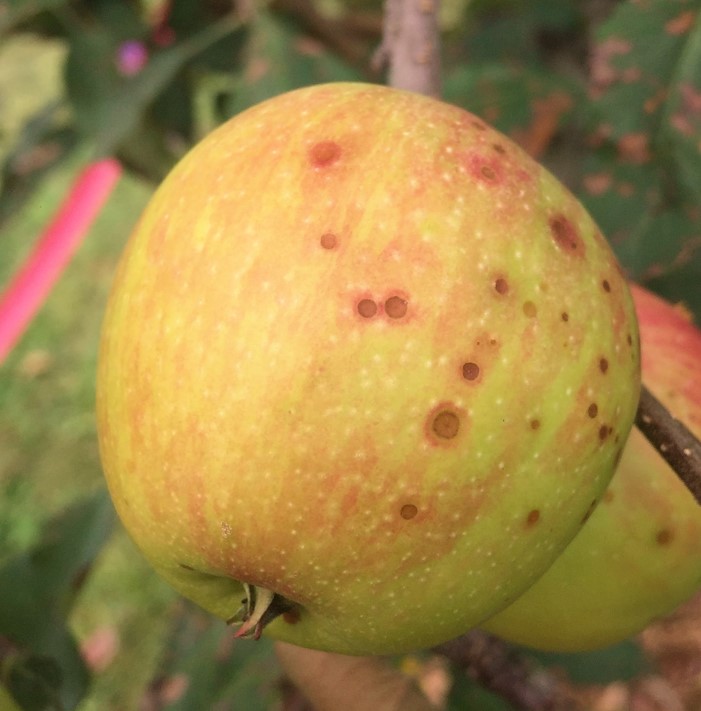GLS and Bitter Rot Management at Harvest
go.ncsu.edu/readext?723674
en Español / em Português
El inglés es el idioma de control de esta página. En la medida en que haya algún conflicto entre la traducción al inglés y la traducción, el inglés prevalece.
Al hacer clic en el enlace de traducción se activa un servicio de traducción gratuito para convertir la página al español. Al igual que con cualquier traducción por Internet, la conversión no es sensible al contexto y puede que no traduzca el texto en su significado original. NC State Extension no garantiza la exactitud del texto traducido. Por favor, tenga en cuenta que algunas aplicaciones y/o servicios pueden no funcionar como se espera cuando se traducen.
Português
Inglês é o idioma de controle desta página. Na medida que haja algum conflito entre o texto original em Inglês e a tradução, o Inglês prevalece.
Ao clicar no link de tradução, um serviço gratuito de tradução será ativado para converter a página para o Português. Como em qualquer tradução pela internet, a conversão não é sensivel ao contexto e pode não ocorrer a tradução para o significado orginal. O serviço de Extensão da Carolina do Norte (NC State Extension) não garante a exatidão do texto traduzido. Por favor, observe que algumas funções ou serviços podem não funcionar como esperado após a tradução.
English
English is the controlling language of this page. To the extent there is any conflict between the English text and the translation, English controls.
Clicking on the translation link activates a free translation service to convert the page to Spanish. As with any Internet translation, the conversion is not context-sensitive and may not translate the text to its original meaning. NC State Extension does not guarantee the accuracy of the translated text. Please note that some applications and/or services may not function as expected when translated.
Collapse ▲ Symptoms of Glomerella leaf spot and bitter rot caused by Colletotrichum fructicola have been rapidly increasing throughout the region over the past few weeks. While we are still examining weather data to better understand later-than-normal symptom development in Western NC, our working theory right now is that the number of consecutive leaf wetting hours was simply too low to trigger an infection event and subsequent symptom development. Although we had a fairly wet July and early August, the majority of significant precipitation events were actually short in duration and occurred in the afternoon, giving the leaves ample time to dry prior to nighttime. In contrast, in 2019 the majority of leaf wetting hours occurred in the evening and leaves would remain wet for much of the morning. With conditions still favorable for GLS and bitter rot, I encourage you to continue on 7 to 10 day fungicide application intervals throughout harvest. While it might be extremely inconvenient to diversify fungicide programs based on cultivar harvest date, adapting cultivar-specific fungicide programs for cultivars highly susceptible to bitter rot may save a lot of heartache (and money) during storage. Here are some additional tips:
Symptoms of Glomerella leaf spot and bitter rot caused by Colletotrichum fructicola have been rapidly increasing throughout the region over the past few weeks. While we are still examining weather data to better understand later-than-normal symptom development in Western NC, our working theory right now is that the number of consecutive leaf wetting hours was simply too low to trigger an infection event and subsequent symptom development. Although we had a fairly wet July and early August, the majority of significant precipitation events were actually short in duration and occurred in the afternoon, giving the leaves ample time to dry prior to nighttime. In contrast, in 2019 the majority of leaf wetting hours occurred in the evening and leaves would remain wet for much of the morning. With conditions still favorable for GLS and bitter rot, I encourage you to continue on 7 to 10 day fungicide application intervals throughout harvest. While it might be extremely inconvenient to diversify fungicide programs based on cultivar harvest date, adapting cultivar-specific fungicide programs for cultivars highly susceptible to bitter rot may save a lot of heartache (and money) during storage. Here are some additional tips:
Bitter Rot Susceptible Cultivars 14 days prior to harvest:
Plan A:
- ~14 days out: Captan 80WDG 3.75lb/A (or 4L 2.5 qt/A) + Prophyt 4 pts/A
- ~7 days out: Merivon 5.5 floz/A + Captan 80WDG 2.5 lbs
- ~Day of Harvest: Merivon 5.5 floz/A + Captan 80WDG 2.5 lbs
Plan B:
- ~14 days out: Captan 80WDG 2.5 lb/A + Ziram 3 lb/A
- ~7 days out: Merivon 5.5 floz/A + Captan 80WDG 2.5 lbs
- ~Day of Harvest: Merivon 5.5 floz/A + Captan 80WDG 2.5 lbs
Plan C:
- ~14 days out: Captan 80WDG 2.5 lbs + Prophyt 4pts/A
- ~7 days out: Captan 80WDG 3.75lb/A (or 4L 2.5 qt/A) + Prophyt 4 pts/A
- ~Day of Harvest: Merivon 5.5 floz/A + Captan 80WDG 2.5 lbs
Glomerella Susceptible Cultivars more than 14 days from harvest:
- Application of Captan 80WDG 3.75 lb/A (or different formulation equivalent)+ Prophyt 4 pts/A OR Captan 80WDG 2.5 lb/A + Ziram 3 lb/A on a 7 to 10 day interval has worked well for us. If flyspeck/sooty blotch, or bot rots are a concern, you may want to include Inspire Super, Topsin (or different t-methyl product), or Aprovia tank mixed with Captan + Prophyt. Keep in mind, Inspire Super, Topsin, or Aprovia applied alone will NOT provide adequate control of Glomerella leaf spot or fruit rot.


